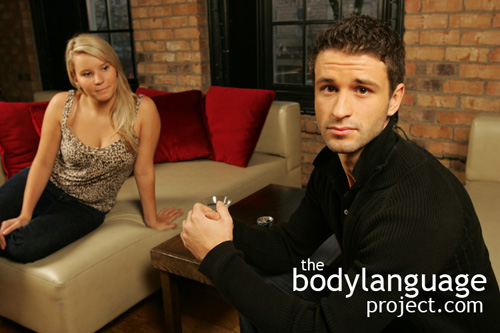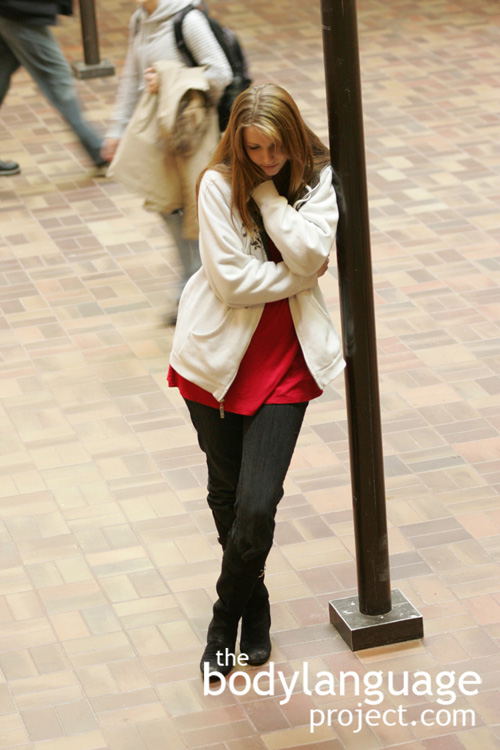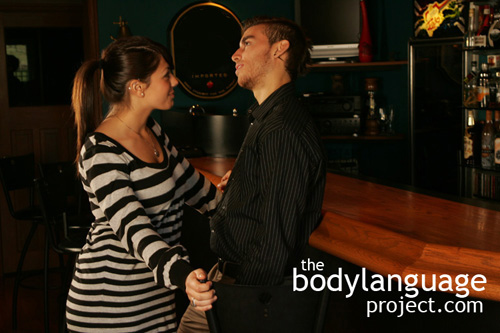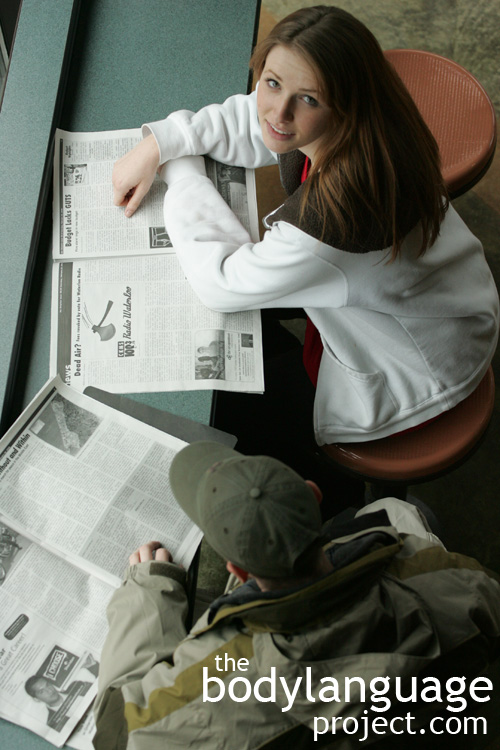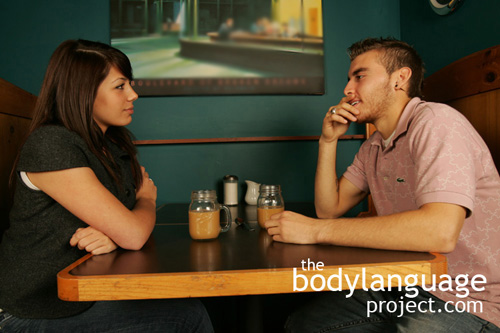Body Language of Hand To Mouth
Synonym(s): Mouth Covering, Lip Playing, Lip Touching, Talking Through The Hand, Fingers To The Mouth.
Description: Hands that cover the mouth while speaking or wrap around the lips. Hands may also play with, or pluck the lips.
In One Sentence: Hands to the mouth signals lack of confidence and insecurity.
How To Use it: Touching the mouth with hands can make one feel more comfortable, however, this self soothing gesture is not seen as positive by others. Therefore, it should be avoided when possible.
Context: General.
Verbal Translation: “I’m timid, shy, lack self confidence. I’m going to play with my mouth or talk through my hand to hide my mouth. This will make me feel more secure because my mouth will be hidden.”
Variant: See Hidden Mouth or Mouth Conceal, Lip Picking, Lip Chewing or Chewing The Lips.
Cue In Action: Dave was on a date but it wasn’t going well as he was really nervous. He felt awkward and it showed. He spent most of the date talking through his hand and mumbling. She could barely hear what he was saying.
Meaning and/or Motivation: A gesture pattern that indicates timidity, insecurity, shyness or lack of self confidence.
Hand-to-face and hand-to-mouth are also sometimes attributed to lying body language although this is only sometimes the case. Hand-to-mouth actions are the most common target for auto touching. It might stem from the concern of giving up too much information, or letting a lie slip, or due to the need for reassurance.
Covering the mouth is a natural reaction children do when they tell a secret or inadvertently say a word they know they shouldn’t. Talking with ones hand covering the mouth “talking through the hand” or resting the hand around the mouth by wrapping the fingers around the top, are significant clues indicating insecurity.
Other times hand-to-mouth indicates female sexual tension such as when the index finger softly rubs against the lips. This is a form of pacifying due to the perceived inability to act on a sexual desire to kiss or be kissed.
Adults that are tense or anxious will play with their mouth or lip. Mouthing a pen, cigarette, piece of their own hair, and even gum when used as a comfort device, are a substitute for the mother’s breast and early childhood mouthing. Sucking, plucking, picking or chewing the lips, rubbing them with a finger or thumb are all forms of auto touching. Confident individuals would never consider using this type of security blanket, let alone be seen touching their faces out of insecurity.
Mouth covering is another way to reduce the pain of telling a lie. In this case, it is so as to “speak no evil.” Small children perform a full cover and even slap their mouths when they say something they shouldn’t. Grown adults will sometimes cup their hands to their mouths like children in effort to “jam the words back in their mouths” but usually use more subtle gestures such as talking through their hand or placing a finger softly over their lips. Subconsciously, hand-to-mouth gestures leads people to distrust others, and see them as less honest overall.
Cue Cluster: Mouth touching is often interchanged with masked arm crossing where the arm is placed across the front of the body forearm against the table. A coffee cup barrier might also be coupled where a drink is held at right angles in front of the body as a cut-off. Eye contact will also be limited, hands might touch the back of the neck, or cheeks.
Body Language Category: Auto contact or self touching, Barriers, Blocking or Shielding, Courtship displays, Low confidence body language, Low confidence hand displays, Nervous body language, Pacifying, Suspicious body language or suspicion.
Resources:
Akehurst, L., G. Kohnken, A. Vrij, and R. Bull. 1996. Lay persons’ and police officers’
beliefs regarding deceptive behaviour. Applied Cognitive Psychology 10: 461-471.
Appelbaum, P.S. The new lie detectors: Neuroscience, deception, and the courts. Psychiatric Services. 2007. 58: 460-462.
Azrin, N.H. ; Nunn, R.G. ; Frantz-Renshaw, S. Habit reversal treatment of thumbsucking. Behaviour Research and Therapy. 1980. 18(5): 395-399.
Bakwin, Harry. Thumb- and finger-sucking in children. The Journal of Pediatrics. 1948. 32(1): 99-101.
Barroso, Felix ; Feld, Jason. Self-touching and attentional processes: The role of task difficulty, selection stage, and sex differences. Journal of Nonverbal Behavior. 1986. 10(1): 51-64.
Buckley, V., & Semple, S. (2012). Evidence that displacement activities facilitate behavioural transitions in ring-tailed lemurs. Behavioural Processes, 90, 433–435.
Bouhuys, A.L. ; Jansen, C.J. ; van den Hoofdakker, R.H. Analysis of observed behaviors displayed by depressed patients during a clinical interview: relationships between behavioral factors and clinical concepts of activation. Journal of Affective Disorders. 1991. 21(2): 79-88.
Berridge CW,Mitton E, ClarkW, Roth RH. 1999. Engagement in a non-escape (displacement) behavior elicits a selective and lateralized suppression of frontal cortical dopaminergic utilization in stress. Synapse 32:187–197.
Bond, Michael H., and Hiroshi Komai (1976). “Targets of Gazing and Eye Contact During Interviews: Effects on Japanese Nonverbal Behavior.” In Journal of Personality and Social Psychology (Vol. 34), pp. 1276-84.
Blakeslee, Sandra (1995). “In Brain’s Early Growth, Timetable Maybe Crucial.” In New York Times (“Science Times,” August 29), pp. C1, C3.
Chase, Richard A. and Richard R. Rubin, eds. (1979). The First Wondrous Year (New York: Macmillan Pub. Co).
Costa, Marco ; Dinsbach, Wies ; Manstead, Antony ; Bitti, Pio. Social Presence, Embarrassment, and Nonverbal Behavior. Journal of Nonverbal Behavior. 2001. 25(4): 225-240.
Caso, L., A. Gnisci, A. Vrij, and S. Mann. 2005. Processes underlying deception: an empirical analysis of truth and lies when manipulating the stakes. Journal of Investigative Psychology and Offender Profiling 2 (3): 195-202.
Cohen, Keith N. ; Clark, James A. Hogan, Robert (editor). Transitional object attachments in early childhood and personality characteristics in later life. Journal of Personality and Social Psychology. 1984. 46(1): 106-111.
D’alessio, M. ; Zazzetta, A. Development of Self-Touching Behavior in Childhood. Perceptual and Motor Skills. 1986. 63(1): 243-253.
DeSteno, D.; Breazeal, C.; Frank, R. H.; Pizarro, D.; Baumann, J.; Dickens, L, and Lee, J. Detecting the Trustworthiness of Novel Partners in Economic Exchange. Psychological Science. 2012. 23, 1549-1556.
http://bodylanguageproject.com/articles/use-body-language-cues-create-trust
Ekman, Paul, and Wallace V. Friesen (1969). “Nonverbal Leakage and Clues to Deception.” In Psychiatry (Vol. 32), pp. 88-106.
Elaad, E. 2003. Effects of feedback on the overestimated capacity to detect lies and the underestimated ability to tell lies. Applied Cognitive Psychology 17(3): 349-363.
Edelstein, R. S., T. L. Luten, P. Ekman, and G. S. Goodman. 2006. Detecting lies in children and adults. Law and Human Behavior 30(1): 1-10.
Frank M.G. and Ekman P. 1997. The ability to detect deceit generalizes across different types of high-stake lies. Source: Journal of personality and social psychology. 72: 1429 -39
Foster, Laura Gutermuth. Nervous Habits and Stereotyped Behaviors in Preschool Children. Journal of the American Academy of Child & Adolescent Psychiatry. 1998. 37(7): 711-717.
Friman, P C ; Mcpherson, K M ; Warzak, W J ; Evans, J. Influence of thumb sucking on peer social acceptance in first-grade children. Pediatrics. 1993. 91(4): 784-6.
Gordon, A. K. and A. G. Miller. 2000. Perspective differences in the construal of lies: is deception in the eye of the beholder? Personality and Social Psychology Bulletin 26 (1): 46-55.
Garnefski N 2004) Cognitive emotion regulation strategies and depressive symptoms: differences between males and female. Personal Indiv Diff 36: 267–76.
Goldberg, Shelly ; Rosenthal, Robert. Self-touching behavior in the job interview: Antecedents and consequences. Journal of Nonverbal Behavior. 1986. 10(1): 65-80.
Goodall, Jane (1986). The Chimpanzees of Gombe: Patterns of Behavior (Cambridge: Belknap Press of Harvard University).
Givens, David B. (1976). An Ethological Approach to the Study of Human Nonverbal Communication (University of Washington Ph.D. dissertation in Anthropology, Ann Arbor: University Microfilms).
Grand, Stanley (1977). “On Hand Movements During Speech: Studies of the Role of Self-Stimulation in Communication Under Conditions of Psychopathology, Sensory Deficit, and Bilingualism.” In Norbert Freedman and Stanley Grand, eds., Communicative Structures and Psychic Structures: A Psycholanalytic Interpretation of Communication (New York: Plenum Press), pp. 199-221.
Harrigan, Jinni A. Self-touching as an indicator of underlying affect and language processes. Social Science & Medicine. 1985. 20(11): 1161-1168.
Harrigan, Jinni A.; Karen S. Lucic; Denise Kay; Anne McLaney and Robert Rosenthal. Effect of Expresser Role and Type of Self-Touching on Observers’ Perceptions. Journal of Applied Social Psychology. 1991. 21(7): 585-609.
Hall, Jeffrey A. and Chong Xing. The Verbal and Nonverbal Correlates of the Five Flirting Styles. Journal of Nonverbal Behavior. 2015. 39:41–68. DOI 10.1007/s10919-014-0199-8
http://bodylanguageproject.com/articles/first-12-minutes-flirting-using-nonverbal-communication-study-reveals-26-body-language-cues-attraction/
Huflejt-Łukasik M, Czarnota-Bojarska J (2006) Short Communication: Selffocused attention and self-monitoring influence on health and coping with stress. Stress Health 22: 153–59.
Heaven, Laura ; Mcbrayer, Dan ; Prince, Bob. Role of sex in externally motivated self-touching gestures. Perceptual and motor skills. 2002. 95(1): 289-94.
Heaven, L ; Mcbrayer, D. External motivators of self-touching behavior. Perceptual and motor skills. 2000. 90(1): 338-42.
Huflejt-Łukasik M, Czarnota-Bojarska J (2006) Short Communication: Selffocused attention and self-monitoring influence on health and coping with stress. Stress Health 22: 153–59.
Honzik, Marjorie P. ; McKee, John P. The sex difference in thumb-sucking. The Journal of Pediatrics. 1962. 61(5): 726-732.
Juni, Samuel ; Cohen, Phyllis. Partial impulse erogeneity as a function of fixation and object relations. Journal of Sex Research. 1985. 21(3): 275-291.
Katza, Carmit; Irit Hershkowitz; Lindsay C. Malloya; Michael E. Lamba; Armita Atabakia and Sabine Spindlera. Non-Verbal Behavior of Children Who Disclose or do not Disclose Child Abuse in Investigative Interviews. Child Abuse & Neglect. 2012. 36: 12-20.
http://bodylanguageproject.com/articles/reading-nonverbal-behaviour-child-abuse-cases-encourage-children-divulge-information-truth-telling
Kenner, Andrew N. (1993). “A Cross-Cultural Study of Body-Focused Hand Movement.” In Journal of Nonverbal Behavior (Vol. 17, No. 4, Winter), pp. 263-79.
Lehman, E.B., Holtz, B.A., & Aikey, K.L. (1995). Temperament and self-soothing behaviour in children: Object attachment, thumbsucking, and pacifier use. Early Education and Development, 6(1), 53–72.
Mohiyeddini, Changiz ; Semple, Stuart. Displacement behaviour regulates the experience of stress in men. Stress. 2013. 16(2): 163-171.
Mohiyeddini, C., Bauer, S., & Semple, S. (2013a). Displacement behaviour is associated with reduced stress levels among men but not women. PLoS One, 8, e56355.
Mohiyeddini, C., Bauer, S., & Semple, S. (2013b). Public self-consciousness moderates the link between displacement behaviour and experience of stress in women. Stress, 16, 384–392.
Mann, S., A. Vrij, and R. Bull. 2002. Suspects, lies, and videotape: an analysis of authentic high-stake liars. Law and Human Behavior 26 (3): 365-376.
Mann, S., A. Vrij, and R. Bull. 2004. Detecting true lies: police officers’ ability to detect suspects’ lies. Journal of Applied Psychology 89(1): 137-149.
Moore, M. M. and D. L. Butler. 1989. Predictive aspects of nonverbal courtship behavior in women. Semiotica 76(3/4): 205-215.
Moore, M. M. 2001. Flirting. In C. G. Waugh (Ed.) Let’s talk: A cognitive skills approach to interpersonal communication. Newark, Kendall-Hunt.
Moore, M. M. 1985. Nonverbal courtship patterns in women: context and consequences. Ethology and Sociobiology 64: 237-247.
Mahalski, P. (1983). The incidence of attachment objects and oral habits at bedtime in two longitudinal samples of children aged 1.5–7 years. Journal of Child Psychology and
Psychiatry, 24(2), 283–295.
Maestripieri D, Schino G, Aureli F, Troisi A. 1992. A modest proposal: displacement activities as an indicator of emotions in primates. Anim Behav 44:967–979.
Morris, Desmond (1994). Bodytalk: The Meaning of Human Gestures (New York: Crown Publishers).
McGrew, W. C. (1972). “Aspects of Social Development in Nursery School Children with Emphasis on Introduction to the Group.” In N. G. Blurton Jones, ed., Ethological Studies of Child Behaviour (Cambridge: University Press), pp. 129-56.
Nolen-Hoeksema S, Aldao A (2011) Gender and age differences in emotion regulation strategies and their relationship to depressive symptoms. Personal Indiv Diff 51: 704–8.
Park, H. S., T. R. Levine, S. A. McCornack, K. Morrison, and M. Ferrara. How people really detect lies. Communication Monographs. 2002. 69: 144-157.
Pease, Barbara and Allan Pease. 2006. The Definitive Book of Body Language Hardcover. Bantam.
Pecora, Giulia ; Addessi, Elsa ; Schino, Gabriele ; Bellagamba, Francesca. Do displacement activities help preschool children to inhibit a forbidden action? Journal of Experimental Child Psychology. 2014. 126: 80-90.
Pugh, George E. (1977). The Biological Origin of Human Values (New York: Basic Books).
Rosenfeld, Howard (1973). “Nonverbal Reciprocation of Approval: An Experimental Analysis.” In Argyle *, pp. 163-72.
Sommer, Robert (1969). Personal Space: The Behavioral Basis of Design (Englewood Cliffs, New Jersey: Prentice-Hall).
Stern, Daniel and Estelle Bender (1974). “An Ethological Study of Children Approaching a Strange Adult.” In Richard Friedman et al. (Eds.), Sex Differences in Behavior (New York: John Wiley and Sons), pp. 233-58.
Stromwell, L. A., P. A. Granhag, and S. Landstrom. 2007. Children’s prepared and unprepared lies: can adults see through their strategies? Applied Cognitive Psychology 21 (4): 457-471.
Sturman, Edward D. Invluntary Subordination and Its Relation to Personality, Mood,
and Submissive Behavior. Psychological Assessment. 2011. 23(1): 262-276 DOI: 10.1037/a0021499
http://bodylanguageproject.com/articles/nonverbal-submission-men-women-depression-critical-examination-use-disuse-submission/
Schino G, Perretta G, Taglioni AM, Monaco V, Troisi A. 1996. Primate displacement activities as an ethopharmacological model of anxiety. Anxiety 2:186–191.
Teixeira Fiquer, Juliana; Paulo Sérgio Boggio and Clarice Gorenstein. Talking Bodies: Nonverbal Behavior in the Assessment of Depression Severity. Journal of Affective Disorders. 2013. 150: 1114-1119.
http://bodylanguageproject.com/articles/using-nonverbal-behaviour-to-assess-depression-severity/
Tamres L, Janicki D, Helgeson VS (2002) Sex differences in coping behaviour: a
meta-analytic review. Personal Soc Psychol Rev 6: 2–30.
Troisi A (2002) Displacement activities as a behavioural measure of stress in nonhuman primates and human subjects. Stress 5: 47–54.
Troisi A (1999) Ethological research in clinical psychiatry: the study of nonverbal
behaviour during interviews. Neurosci Biobehav Rev 23: 905–913.
Troisi A, Moles A (1999) Gender differences in depression: an ethological study
of nonverbal behaviour during interviews. J Psychiatr Res 33: 243–250.
Tamres L, Janicki D, Helgeson VS (2002) Sex differences in coping behaviour: a
meta-analytic review. Personal Soc Psychol Rev 6: 2–30.
von Hippel W, von Hippel C, Conway L, Preacher KJ, Schooler JW, et al. (2005) Coping with stereotype threat: denial as an impression management strategy. J Personal Soc Psychol 89: 22–35.
Vrij, A. and G. R. Semin. 1996. Lie experts’ beliefs about nonverbal indicators of
deception. Journal of Nonverbal Behavior 20: 65-80.
Vrij, A. 1997. Individual differences in hand movements during deception. Source: Journal of nonverbal behavior. 21: 87-102.
Vrij, A.. 2004. Why professionals fail to catch liars and how they can improve Source: Legal and Criminological Psychology. 9:159-181.
Vrij, A., S. Mann, and S. Kristen. 2007. Cues to deception and ability to detect lies as a function of police interview styles. Law and Human Behavior 31 (5): 499-518.


